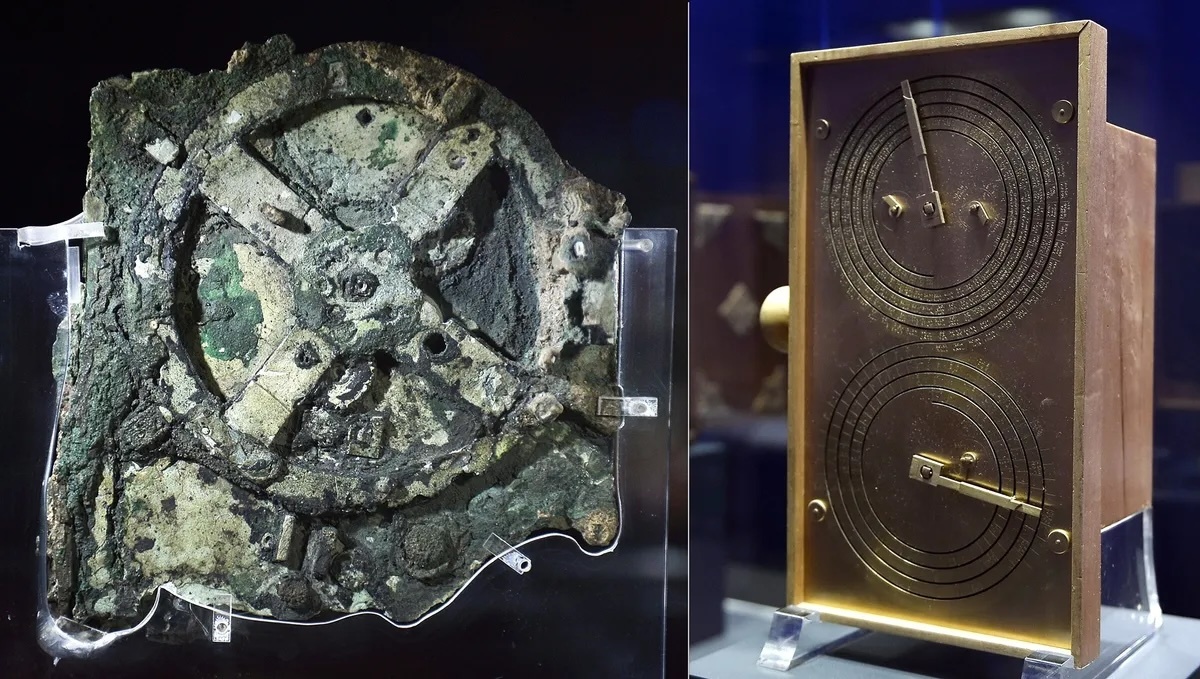3.07.2024
Gravitational wave research has helped scientists learn more about a famous 2,000-year-old mechanical computer.

The Antikythera Mechanism, sometimes described as the world's oldest computer, on display at the Archaeological Museum in Athens. Right: A modern-day replica of the mechanism. (Image credit: Louisa Gouliamaki/AFP)
Fresh research about ripples in the fabric of spacetime suggests a nearly 2,000-year-old cosmic calculator followed the lunar calendar instead of the solar one.
The hand-powered "Antikythera mechanism" was retrieved in pieces from a sunken shipwreck in the Aegean sea in 1901, sparking more than a century of research into how this device was made — and why. The box-shaped mechanical computer used gears and dials to track ancient astronomical events such as solar eclipses and the movements of planets.
Now, researchers are using cutting-edge work surrounding gravitational waves, which are ripples in spacetime sparked by events like black hole mergers or collisions between stars, to help uncover the mechanics of Antikythera's Ancient Grecian gears. (The device is named after the Greek island near where it was found.)
"It's given me a new appreciation for the Antikythera mechanism and the work and care that Greek craftspeople put into making it — the precision of the holes' positioning would have required highly accurate measurement techniques, and an incredibly steady hand to punch them," study co-author Joseph Bayley, a research associate at the University of Glasgow's physics and astronomy department, said in a statement.
The new study is built on previous research in 2021 that used X-ray to show "fresh details of regularly spaced holes" beneath one of the mechanism's broken rings, the statement says. Known as a "calendar ring", this section is labeled with ancient Egyptian month names engraved in ancient Greek, according to the British Horological Institute.
Computerized X-ray imaging "also revealed inscriptions describing the motions of the sun, moon and all five planets known in antiquity and how they were displayed at the front as an ancient Greek cosmos," reads the older 2021 study, published in Nature.
That 2021 study also noted the interdisciplinary nature of the Antikythera mechanism: "Solving this complex 3D puzzle reveals a creation of genius — combining cycles from Babylonian astronomy, mathematics from Plato's Academy and ancient Greek astronomical theories."

Exploded model of the cosmos gearing of the Antikythera Mechanism. (Image credit: ©2020 Tony Freeth)
The new study, in the Horological Journal, suggests researchers can predict just how many holes were in the calendar ring using statistical models that are derived, in part, from gravitational wave research. The ream found the calendar ring likely contained 354 holes, which follows a lunar year of 354 days (or 12 cycles of the moon waxing and waning). Unlike the 365-day solar year most of the world uses today, the Ancient Egyptian calendar followed the lunar year, as does the Islamic calendar still widely used around the world.
The team also drew inspiration from YouTuber and machinist Chris Budiselic's channel, Clickspring. Budiselic has been building a replica of the Antikythera mechanism while performing independent research. Budiselic's team suggested the ring could contain anywhere between 347 and 367 holes.
One form of analysis, led by Glasgow astrophysics professor Graham Woan, came from Bayesian statistics. This "uses probability to quantify uncertainty based on incomplete data," the statement said.
The other portion, from gravitational wave research led by Bayley, was adapted from statistics used with data from the LIGO (Laser Interferometer Gravitational-Wave Observatory) that seeks out spacetime ripples. (Woan is also a LIGO researcher.)
Both statistical studies independently suggested the ring has either 354 or 355 holes. Previous studies had suggested the lunar calendar was more important to the makers of the Antikythera mechanism, but the new study "greatly increases the likelihood that this was the case," Bayley said in the statement.
"It's a neat symmetry," added Woan, "that we've adapted techniques we use to study the universe today to understand more about a mechanism that helped people keep track of the heavens nearly two millennia ago."
Quelle: SC
